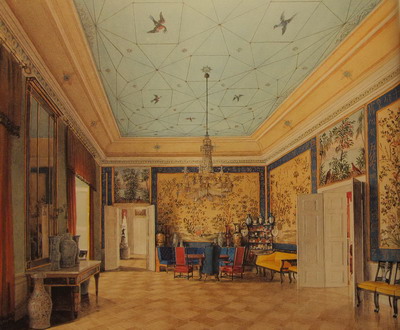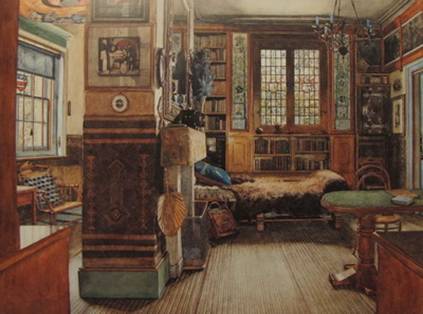
Chinese Room in the Royal Palace Berlin, Germany, 1850 Eduard Gaertner
Chinese flower and bird wallpaper and pseudo-Chinese characters in gold on the wallpaper’s blue borders record royal fascination with Chinese style in the 1820s. On the artificial ceiling - a glass roof - are all kinds of birds. The room also houses several Oriental porcelain and black-and-gold-lacquered cabinets.

Sir Lawrence Alma-Tadema’s Library in Townshend House, London, 1884
Anna Alma-Tadema. The ground and the wall were covered with tatami mats. The textile hung against the wall looks like batik fabrics from Southeast Asia. A cattail leaf fan reflects a strong Oriental style.
Two prestigious French historians, Phillippe Ariès and Georges Duby, once said in A History of Private Life, “The private person has to face the reality in the office, so he/she needs to be nourished by illusion created in the habitable rooms…A house is like a private kingdom."
“Romantic Interiors - Nineteenth Century Watercolors,” an art exhibit now at Beijing World Art Museum, features 72 works from the Cooper-Hewitt, National Design Museum in New York. It displays how Neoclassicism, Gothic, and so-called Chinese-style elements were placed to generate illusions in the living rooms, studies, libraries and bedrooms of Europe's upper-middle class two centuries ago.
Quite a few watercolor paintings show that Chinese ceramics, chairs and other decorative motifs played an important role in European interior design during that period
As early as the 18th century, Chinese exotica became fashionable in Europe. In French there is even a term, “Chinoiserie,” which means “Chinese style.” Chinoiserie is actually a mix of Chinese, Egyptian, Japanese and Moorish decorative motifs.
A British writer at the time described that the Chinese porcelain tea set "has become a fashionable lady-must -have collection."
Flowers and birds, dragons and bamboo, wicker and other Chinese-style motifs were employed to decorate wallpaper and chairs in the living room, and nightstand in the bedroom, Even bed mattresses and bed curtains had a strong Chinese flavor. European designers invented these elaborate designs based on their knowledge of and imagination about Chinese culture. It is said that sometimes the people and animals depicted on some wallpapers do not exist at all.
